Songzanlin Scenic Area is located near Niwang Road, Shangri-La City, Diqing Tibetan Autonomous Prefecture, Yunnan Province. It is a national 4A-level tourist attraction and the largest Tibetan Buddhism monastery in Yunnan, known as the "Little Potala Palace". It is a masterpiece of Tibetan plastic arts and is also praised as the "Tibetan Art Museum". The main monastery of the scenic area covers an area of 33 hectares, with a grand scale. The monastery houses precious cultural relics such as eight gilded Sakyamuni Buddha statues, palm-leaf scriptures, Thangka paintings exquisitely painted with five-color gold juice, golden lamps, and the Buddhist scripture Tanjur.
History and Culture
Ganden Songzanlin Monastery was built in 1679 with the approval of Emperor Kangxi of the Qing Dynasty, and its location was selected by the 5th Dalai Lama through divination. The basic construction was completed in 1681, and the 5th Dalai Lama named it "Ganden Songzanlin", meaning "the resting place of the three gods". In the second year of the Yongzheng reign of the Qing Dynasty, the Qing government officially named it "Guihua Monastery" (Monastery of Sinicization).
In the summer of 1936, when the Second Front Army of the Chinese Workers' and Peasants' Red Army, led by leaders such as He Long, passed through Shangri-La during the Long March, He Long visited Guihua Monastery in person, called on the Living Buddhas and lamas, and presented a silk banner inscribed with "Prosper the Tibetan People". The monastery was damaged during the "Ten-Year Turmoil" (1966-1976), and the existing parts of the monastery were rebuilt after 1981. In 1982, the National Religious Affairs Bureau awarded Ganden Songzanlin Monastery the honorary title of "Patriotic Education Base".
In December 2024, it passed the provincial-level preliminary assessment of landscape quality for national 5A-level scenic areas and is currently applying to the National Tourism Administration for the official 5A-level certification.
Major Attractions
Zacang Hall and Jikang Main Hall
Zacang Hall and Jikang Main Hall are built on the highest point, standing in the center of the entire monastery. They are 5-story Tibetan-style carved buildings. The upper floor of the main hall is covered with gilded copper tiles, and the corners of the hall have decorative animal-shaped eaves, incorporating the architectural style of Han Chinese temples. The lower hall has 108 pillars, a number symbolizing auspiciousness in Buddhism, and can accommodate 1,600 people sitting cross-legged to recite scriptures.
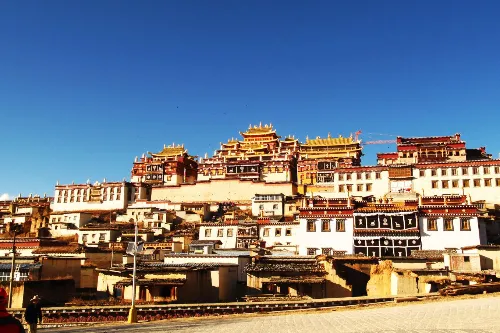
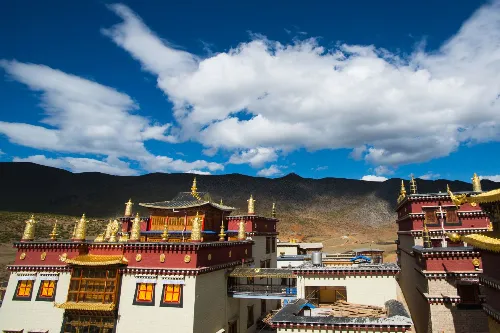
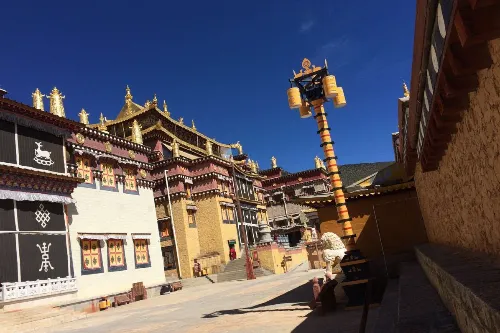
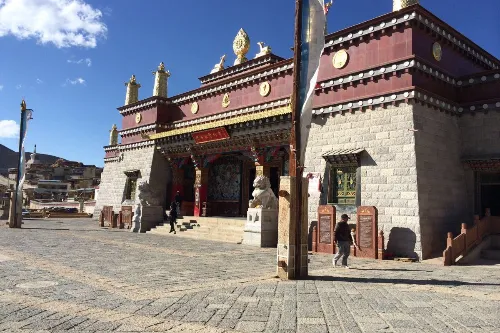
Lhamo Yumtso Lake
Lhamo Yumtso Lake is located near Songzanlin Monastery, with an altitude of 3,282 meters above sea level. Its water area can reach 21.5 hectares during the rainy season. The lake is replenished not only by underground springs along its edges and within the lake but also mainly by surface water during the rainy season, making it a seasonal lake. Various waterbirds such as black-necked cranes and yellow ducks inhabit the lake area. When viewed from the main hall of Songzanlin Monastery, the lake water is as clear as a mirror, reflecting the surrounding mountains in a harmonious scene.
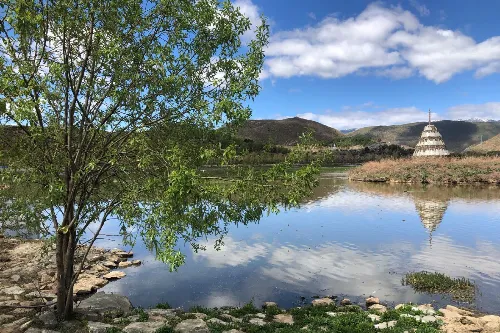
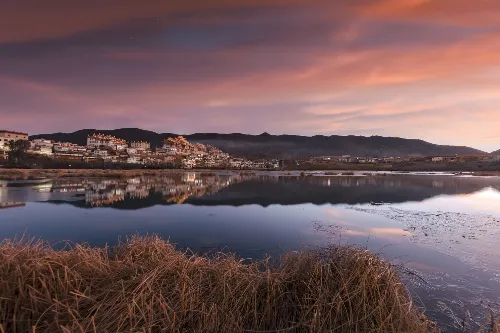
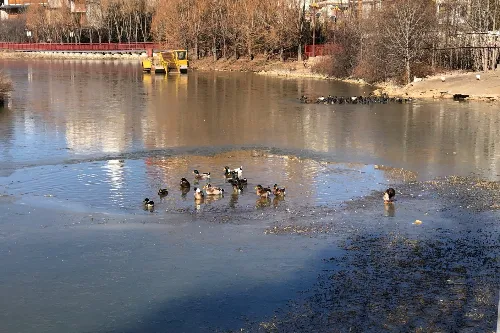
Tour Routes
Lake Circuit Boardwalk Route: Songzanlin Monastery Gate → Floating Bridge → Distant View Shooting Spot → Dongqusheng → Sacred Tree → Xiaojiezi (Small Street) → Lhamo Yumtso Square → Sacred Spring → Songzanlin Monastery Viewing Platform. Duration: Approximately 1 hour.
Essential Route: Songzanlin Monastery Gate → Tsongkhapa Hall → Zacang Hall → Main Sakyamuni Buddha Hall. Duration: Approximately 1.5 hours.
Outer Circuit Route: Songzanlin Monastery Gate → Lhamo Yumtso Lake Square → Bodhi Stupa. Duration: Approximately 1 hour.
Inner Circuit Route: Songzanlin Monastery Gate → Jidi Kangtsen → Zhaya Kangtsen → Tsongkhapa Hall → Zacang Hall → Main Sakyamuni Buddha Hall → Rongba Kangtsen → Doke Kangtsen → Songzanlin Monastery Gate. Duration: Approximately 3 hours.
Travel Tips
- It is recommended to visit between March-May and September-November, as the scenery is most beautiful during spring and autumn.
- Follow the free guides provided by the monastery to gain a deeper understanding of Tibetan Buddhist culture.
- If time permits, choose the Inner Circuit Route to fully experience all the scenic spots in the area.
- To take a panoramic photo of the monastery, go to the Distant View Shooting Spot on the Lake Circuit Boardwalk.
Notes
- Whether visiting the main hall of the monastery, the Buddha stupas, the incense-burning platforms, or the mani stone piles, you must move in a clockwise direction (a traditional practice in Tibetan Buddhism).
- After getting off the sightseeing bus, you need to climb stairs to enter the monastery. It is advisable to bring a small oxygen tank to prevent altitude sickness and rest in place if you feel tired.
- Respect the local religious beliefs and customs; do not touch religious items such as Buddha statues or prayer flags casually.
- Photography is prohibited in some areas of the scenic spot; please pay attention to the signs.
Transportation
- Bus: Take Bus No. 3 from the bus stops at the entrance of Dukezong Ancient Town or on Changzheng Avenue to the scenic area's visitor center.
- Self-driving: Navigate directly from Dukezong Ancient Town to the Songzanlin Monastery Parking Lot; parking is free.
- Taxi: Taking a taxi from Dukezong Ancient Town costs approximately 12 yuan and takes about 15 minutes to reach the scenic area entrance.
Opening Hours
Winter: 07:00-19:30 (it is recommended to purchase tickets and enter the scenic area no later than 17:30); Summer: 07:00-20:00.
Ticket Information
Full ticket: 90 yuan per person; Half-price ticket: 62 yuan per person.
You can search for the scenic area's official WeChat public account "松赞林景区保护开发有限责任公司" to get the latest updates or purchase tickets online.
Online Booking
Click here to jump to the Trip.com ticketing platform for ticket purchase.


